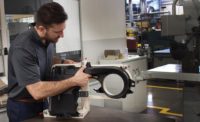MINNEAPOLIS & REHOVOT, Israel — Stratasys announced that Ricoh Japan is replacing traditional metal tooling with customized, lightweight 3D printed jigs and fixtures for its Production Technology Center assembly line—improving manufacturing efficiency while minimizing manual tooling errors. The assembly line, located in the northeast branch of Ricoh Industries in Miyagi prefecture, Japan, is dedicated to manufacturing large-format printers.
Assembling an electronic component using a 3D printed fixture produced in anti-static ABS plastic on the Stratasys Fortus 900mc Production 3D Printer improves manufacturing efficiency.
By producing the tools in durable ABS thermoplastic on its Stratasys Fortus 900mc Production 3D Printer, Ricoh is able to customize each tool precisely according to the part geometry while reducing the tool's weight. This has enabled Ricoh to accelerate the manufacturing process in which an operator typically handles more than 200 parts each day.
Ricoh develops and manufactures high quality office equipment such as copiers, fax machines and projectors. The competitive nature of the electronics industry led the company to look for new ways to accelerate product launches while maintaining or lowering its production costs.
"Because we are producing an enormous number of parts, it takes a lot of time and effort to identify the right jigs and fixtures for each one. This manual process has become even lengthier as the number of components grows, requiring that an operator examine the shape, orientation and angle of each part before taking out a tool and placing it back in its original fixture. The operators were occasionally annoyed with the many different tools, and we were looking for a way to accelerate tooling to match our manufacturing schedule," said Taizo Sakaki, senior manager of business development at Ricoh Group. "Now with Stratasys 3D printing, we are able to customize the tools according to the part and produce them on demand which is helping us restructure and modernize our production process."
Geometric Design Freedom: Optimize the Workbench with 3D Printed Fixtures
Prior to 3D printing, Ricoh had to outsource machine cut tools which could take two weeks or more. Now, Ricoh's operators can determine the shape and geometry of a fixture that corresponds to its associated part through 3D CAD software and 3D print it in one day. This leaves the workers more time to attend to other stations. Moreover, new hires can now adapt to the tools and the workstations in two days when previously a new worker had to spend at least one week to learn all the tools. The jigs and fixtures are also much lighter so that workers can use them for a prolonged period of time without fatigue.
"The Stratasys Fortus 900mc 3D printing solution enables us to realize designs that are difficult for conventional cutting methods to replicate, such as hollow interiors, curves or complex shapes. The material used to 3D print the tools is very strong and anti-static which is important due to the large number of electronic components we are assembling, adding to the advantages of Stratasys 3D printing," explained Sakaki.
A Catalyst for Innovation with Digital Manufacturing
Ricoh's large-format printer assembly plant has pioneered the adoption of digital manufacturing, and the company continues to explore areas where 3D printing can be applied to expedite workflows, such as molding and low-volume production—releasing more resources and expanding its scope for its diverse customer base.
"Ricoh embraces technology and we are delighted to lead the industry in adopting innovation in our business. Our workbench has become more flexible and more efficiently organized, and our operators are all happy about that," said Masami Hirama, Director of Production Innovation Center at Ricoh.
"At Stratasys, we are committed to helping our customers overcome the constraints of traditional workflows and processes with a complete ecosystem of 3D printing expertise, technologies and services. Ricoh illustrates perfectly how manufacturing aids 3D printed with Stratasys additive technology empower manufacturers to increase their efficiency and flexibility while ultimately becoming more competitive," commented Omer Krieger, President of Stratasys Asia Pacific & Japan. "Customized 3D printed jigs and fixtures can play an important role in enabling companies to get products to market faster and are a great example of how Stratasys applies purposeful innovation to manufacturers' goals and aspirations. Whenever you can reduce a process from weeks to days - that is a solution worth exploring."
For more information, visit www.stratasys.com.









